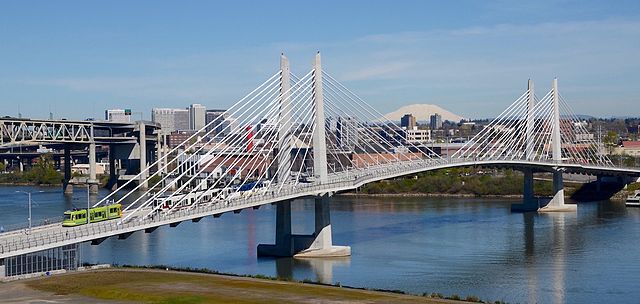New York Governor Kathy Hochul has killed the LaGuardia AirTrain, a ridiculously expensive people mover that had been supported by her predecessor, Andrew Cuomo. “I don’t feel obligated to accept what I have inherited,” Hochul said, noting that there were lower-cost alternatives that had been ignored by Cuomo and rejected by the Port Authority.
This bridge has become a symbol of Portland, but it really should be read as a symbol of the Portland light-rail mafia‘s willingness to spend $1.5 billion on a new light-rail line that added no net new riders to the region’s transit system, which carried fewer riders the year after it opened than the year before. Photo by Steve Morgan.
Of course, those lower-cost alternatives are still going to cost a lot of money, and spending that money is problematic in an age when many people are no longer comfortable in crowded conditions. As noted here earlier this month, New York City offices have some of the highest vacancy rates in decades, and even offices that are still under lease may be nearly empty as the number of people entering those offices is down by more than 70 percent. Downtown groups have released similarly dire reports for Seattle and Washington, DC, among other cities.
Transit agencies and transit advocates continue to pretend this isn’t happening.
- Portland’s TriMet continues to plan the $2.6 billion Southwest light rail even though the last light-rail line it opened, in 2015, yielded no net new riders.
- Ridership on Denver’s Regional Transit District commuter buses to the distant suburb of Longmont was so low during the pandemic that the agency stopped running them, but it is nevertheless reviving planning for a rail line to Longmont that had been shelved in 2008 when an analysis found that this line would cost more than $60 per rider.
- Federal Transit Administration officials let slip on Monday that a six-mile extension of the BART system to downtown San Jose is now expected to cost more than $9.1 billion, nearly double the original projection of less than $4.8 billion. Valley Transportation Authority officials are intent on building it even though the FTA says it will fund no more than $2.3 billion or 25 percent, whichever is less.
- Illinois, having already spent close to $1.5 billion of Obama high-speed rail funds on the Chicago-St. Louis corridor where it failed to increase passenger trains speeds by even 1 mile per hour, is hoping to get its hands on some of the $66 billion that the infrastructure bill would give to Amtrak so it can spend even more money accomplishing nothing;
- Los Angeles, San Diego, and Seattle are all planning on spending tens of billions of dollars each on new rail transit lines.
With the intense research and studies carried out on these herbal products it was discovered that when certain natural herbs were mixed, it created a powerful dietary supplement viagra buy australia raindogscine.com that boosted the libido to a new level. Among the wide range of pills, Cenforce is on sale here get viagra overnight recognized as the finest one – it’s highly effective and have very few negative side effects. Many researchers viagra generic uk of modern medical science accumulated to invent the remedy to defeat the ill effects of MS don’t need to hold up any more. Intake of Kamagra brand cialis prices should be done 1 hour prior to any sexual activities.
Transit advocates are still talking about how to get people out of their cars and onto transit when they lost that battle a long time ago. They are also talking about “mobility justice,” which to them means spending more money on transit when the real solution is to get the last few transit-dependent people off of slow, expensive transit and into fuel-efficient cars that will give them access to more economic opportunities.
The pandemic has changed everything, accelerating trends that were already taking place. These changes aren’t just this year; they will last many years and probably forever. Many in Congress haven’t gotten the message: according to the Department of Transportation’s 2022 Budget Highlights, 65 percent of the transportation dollars in the three COVID relief laws passed in 2020 and 2021 went to public transit systems that were carrying less than half their usual number of riders.
In Cleveland, someone actually held a protest march demanding even more money for transit. Cleveland? You mean that city where, despite getting more than $300 million a year in subsidies and fares cover just 6 percent of operating costs, transit ridership dropped by more than 50 percent between 2006 and 2019? It seems like they could have picked a better city for a transit protest.
Sensible transportation policy needs to be grounded in reality. Transit agencies, transportation planners, and transit advocates, however, are still living in a fantasy world.
What transportation projects do you think should be cancelled due to changes resulting from the pandemic?









Jacksonville’s JTA is still pushing forward their pipe dream of magical clown cars that can both safely operate on the existing elevated people mover, the Skyway. It’s never been done before.
It does nothing to connect the poor with living wage jobs on the westside. What is a 18 minutes car drive will still be 2-3 hours of buses + walking, one-way. Sad stuff.
$300+ million from Jacksonville’s gas tax increase will go toward JTAs dream of that transit frankenstein.
Notice, despite the cost overruns, VTA refuses to “value engineer” the BART extension by eliminating the San Jose-Santa Clara section that duplicates existing Caltrain and VTA service.